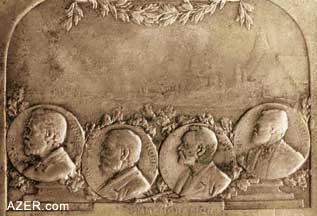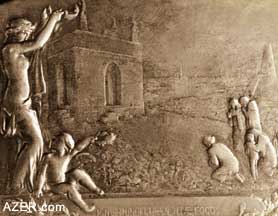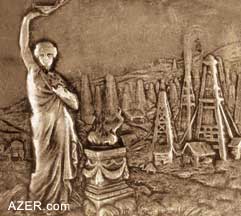|
10th Century The 10th century Arabic author al-Masudi writes about the volcanic activity and burning fires in his history, "Fields Of Gold and Mines Of Precious Stones". He describes the history and geography of many countries, including Azerbaijan. It is not known if he had visited Azerbaijan or whether he had gathered the information from other sources. He describes both the eruption of a mud volcano and a fountain of the burning oil, the source of which originated from beneath the surface of the earth. This information might be correct as eruptions of oil fountains and mud volcanoes are still visible on the Absheron Peninsula and some of the islands of the Caspian Sea. Al-Masudi observes: "There is a volcano in the oil-producing area of Shirvan. This volcano is a fire-breathing source, and it never ceases to expell long jets of flame."  14th Century Abdurrashid of Baku wrote a book in the 14th-15th century entitled: "The Description Of Monuments and Miracles of the Mighty Lord." He also provides a description of a burning gas source. "During certain years, people in Baku observe a flame coming from the sea and erupting upward. It can be observed from a distance of two days' journey or more. After burning for a considerable time, the flame disappears". 17th century Today, on the outskirts of Baku is a place called "Atashgah" where there is a walled complex called "Atashgah" that was used by Fireworshippers and which now has been converted to a museum. It is located on the Absheron Peninsula in a region that is known as "Surakhani". This word is derived from the Persian words "Surakh" (hole) and "khani" (source or fountain). According to historical sources, before the construction of the Indian Temple Of Fire (Atashgah) in Surakhani at the end of the 17th A.D., the local people also worshipped at this site because of the "seven holes with burning flame". And thus the name "Surakhani" - holes with burning fountains. Engelbert Kaempher, a British traveler, who visited Atashgah in 1683 writes: "Previously, at about 500 paces distance from the temple, there could be seen seven holes situated in a single line. In early times, flames used to erupt from these holes. Then, the fire disappeared and burst forth at another locale where later the Atashgah was built". From Azerbaijan International (11.2) Summer 2003. |


